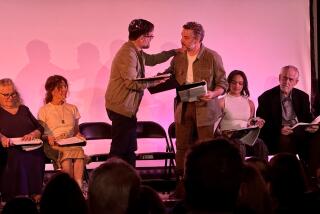A Personal Portrait of an Uprising
- Share via
RAMALLAH, West Bank — Some visitors to the Khalil Sakakini Cultural Center here come to see the tan hiking boots once worn by Mohammed Durra, the slain 12-year-old whose picture--showing him cowering beside his father--has become one of the most incendiary images of the 5 1/2-month-old intifada.
Others admire the roughly carved slingshot that 15-year-old Fares Odeh used to fling stones at Israeli tanks--until he took a fatal bullet in the neck.
Or the unfinished piece of embroidery that Rahma Hindi, 54, was working on before she was killed by an Israeli missile.
The footwear, slingshot and stitchery are part of an unusual exhibit of photographs and treasured items belonging to the first 100 people killed by Israelis in the ongoing Palestinian uprising against rule by the Jewish state in the West Bank and Gaza Strip.
The idea for the memorial exhibit was hatched in October when Palestinians were being killed in clashes almost every day, their identities unknown to the vast majority of their compatriots. Since the uprising broke out at the end of September, about 425 people have been killed, 80% of them Palestinians.
Organizers say the exhibit, funded by the Ford Foundation, is intended to help visitors see the dead as individuals, not mere statistics.
“We want people to get to know them, and we want to give them back their individuality,” said Adila Laidi, director of the cultural center. “These people sacrificed their lives for independence. Why should they remain anonymous?”
Many Palestinians are paying attention. The exhibit, which opened in Ramallah in mid-February and was expected to run for only two weeks, is now in its fourth week thanks to hundreds of visitors. Organizers plan to take their show to six cities in the West Bank and Gaza Strip, then on to Jordan, Egypt and Europe.
Some Israeli critics say the exhibit is part of an effort to manipulate the memory of the dead and portray Israelis to the Western world as child-killers.
Laidi defended the show, saying: “When many of these people died, their mothers, friends and relatives did not have a chance to grieve. This gives them an opportunity for closure.”
The exhibition hall at the Sakakini center usually hosts concerts, displays of elegant paintings and Palestinian folk art. The noted Palestinian poet Mahmoud Darwish maintains an office on the second floor.
But the center has been converted into a shrine for this exhibit. Tea candles flicker on the bare stone floor. Black-and-white photographs of the dead are mounted on the wall. Under each photo is a translucent plastic box containing a belonging or two, each wrapped with twine like a present.
A GameBoy. A soccer ball. Tools. A perfume bottle. An empty bird cage. Crayon drawings of a boy flying a kite.
Descriptions of the dead are contained in a 208-page catalog that Laidi and the staff of her nonprofit organization compiled. The stories, Laidi said, bear witness to the Palestinian condition. Many lived in cramped and miserable refugee camps. Some were so poor that they hadn’t had their pictures taken in years, forcing the exhibit’s curators to use whatever pictures their families could muster.
Many died in clashes with soldiers. But there are many exceptions. There’s Harald Fischer, a German-born chiropractor who was killed by an Israeli missile as he tried to help neighbors. And Bassam Bilbeissi, an ambulance driver who was slain as he tried to rescue Durra. Bilbeissi’s paramedic uniform is part of the exhibit.
Chadi Barghouti, a Sakakini employee who gathered items for the exhibit, said he left with stories even more precious.
On the day that 15-year-old Nizar Eideh of Ramallah died in clashes with soldiers, he released a bird he had bought three days earlier. Barghouti said the boy explained to his mother that he didn’t want the bird’s mother to miss him.
More to Read
Sign up for Essential California
The most important California stories and recommendations in your inbox every morning.
You may occasionally receive promotional content from the Los Angeles Times.










